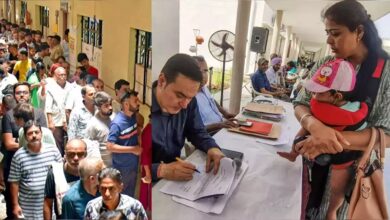Doctor’s Panel : Dr.Nilanjan Mukherjee (Pediatrician)exclusively with his weekly Advice

Dr.Nilanjan Mukherjee is with News Mania– Doctor’s Panel (Publishers Companion )where he will share his valuable advice, knowledge and awareness for Child care and more every week.

Dr.Nilanjan Mukherjee from Raiganj is a Pediatrician.
He works with children and adults with Autism, Down Syndrome, Cerebral Palsy and other intellectual and developmental disabilities. His service includes early intervention to kids aged 0-12 years old.
News Mania: What are the 4 pediatric age categories?
Dr. Nilanjan Mukherjee : The four pediatric age categories as per the National Institute of Child Health and Human Development as infancy (28 days-12 months),
The infant to one year is also divided in two parts. One is Neonet and post neonatal infant.(A neonate is also called a newborn. The neonatal period is the first 4 weeks of a child’s life. It is a time when changes are very rapid. Many critical events can occur in this period: Feeding patterns are established.)
Toddler (13 months-2 years), Children reach milestones in how they play, learn, speak, behave, and move (like crawling, walking, or jumping). During the second year, toddlers are moving around more, and are aware of themselves and their surroundings. Their desire to explore new objects and people also is increasing Early childhood (2-5 years), our four-year-old isn’t a toddler anymore, but a full-fledged preschooler. Like many parents, you may be wondering what developmental milestones await you and your four-year-old, particularly as you anticipate kindergarten in the not-so-distant future.
Middle childhood (6-11 years) Children between the ages of 6 and 12 are in the age period commonly referred to as middle childhood. As an age group, 6- to 12-year-olds are less obviously set apart than infants, adolescents, and even preschool children are in most Western societies.
and Early adolescence (12-17 years). While this transition is different for every child, early adolescence is usually defined as the period between 10 and 15 years of age. Early adolescence is the time between childhood and adolescence, while adolescence is the time between childhood and adulthood.

News Mania: If a child complained about a continuous pain on their leg for the past two weeks, what would you suspect?
Dr. Nilanjan Mukherjee: Actually, in children, the growth pain is the commonest in legs. If there is no history of trauma, then it probably would be due to some growth pain, which mainly increases at night time, when the child is going to sleep or calm and quiet. At that time, this pain was much more. And it occurs due to the increase in length of the child and the leg length also increases. And this time, because this is the period when the child increases in length and height, and grows taller so this pain is not much to worry but to treat with proper rest and medicine.
News Mania: Imagine that a parent calls and tells you their child has high fever and a rash. How do you respond?
Dr.Nilanjan Mukherjee : Such a condition depends on what the age of the child is because of fever and rash together, which is due to a lot of ailments which need to be diagnosed. The most difficult and dangerous one is Dengue fever. In most cases of dengue symptoms with plain fever, But in few cases it occurs due to dengue hemorrhagic fever. So we have to be alert and cautious if there is any probability of the shock syndrome. Another is Carlet fever, in which rash is the common symptoms. There are some viral issues where there is fever associated with rash and definitely scrap typhus.
Typhus sometimes becomes difficult because of convulsion which is a matter of concern. We should go to the nearest physician though initially paracetamol is given but the rare ship associated with it. So we must thoroughly investigate it and treat accordingly.

News Mania: What is the biggest challenge in pediatrics?
Dr.Nilanjan Mukherjee : Yes, the biggest challenge is always that your patient is almost always silent regarding his own problems because the child is not able to express as most of the paediatric patients come under the age of 2 years. So before 2 years, the child is not able to express his needs, pain and trauma. Though the challenge becomes a bit easier when we take all the history from their parents or guardians or accompanying people.
News Mania: Can you explain the meaning of triage?
Dr.Nilanjan Mukherjee : Triage is the sorting of children into priority groups according to their medical need and the resources available. After these steps are completed, proceed with a general assessment and further treatment according to the child’s priority. And then from there we have to take decision whether to be admitted or to treat through medicine. So it is very important part, where very efficient person should to entrust to monitor the condition.
News Mania: What would you tell a parent who isn’t sure that they should vaccinate their baby?
Dr.Nilanjan Mukherjee : Many parents worry that multiple vaccines will overload their child’s immune system. But children are exposed to hundreds of germs every day. In fact, a common cold or sore throat will put a greater burden on your child’s immune system than vaccines. So, Vaccination is very much necessary for each and every child for the protection of the child. As per government schedule it is given keeping the fatal disease in mind. But there are certain vaccines which are given after discussion with the guardians and condition of the child. But the minimum vaccination which is according to UIP or universal immunization procedure must be given to all the children where such campaigns and distribution takes place.

News Mania: What is the meaning of unprivileged children are they physically or socio economic ?
Dr. Nilanjan Mukherjee: Many times, this word is used as a synonym for poor. People often worry about underprivileged children who are living in poverty and may not have access to healthy food or good medical care. Underprivileged children often go to the worst schools too, which is another disadvantage. So underprivileged means that they do not get everything of facilitating their life and every facility of their normal society. The low socioeconomic background sometimes causes physical problem and the disability from the very early stage is ignored resulting to severe condition, which becomes difficult for us to treat and give result as required.
News Mania: How do you decide when to prescribe an antibiotic? How do you decide which one?Dr.Nilanjan Mukherjee :It is a universal question. It is a big one because antibiotic is used only when there is suspicion of infection and also sometimes to be in safe side in case of viral fever or viral infection. Children should only receive an antibiotic to treat an infection that is caused by bacteria. Colds are caused by viruses, and should not be treated with antibiotics. It’s okay to ask your doctor if they think your child’s infection was caused by a virus or bacteria and if an antibiotic is necessary.
It is a major concern to whether prescribe this broad spectrum or narrow spectrum antibiotic. It is according to the need of the patient. So it is used initially when there is mild infection. It is the narrow spectrum antibiotic or there may be according to the infection it is gram positive gram negative infection. So it is specific antibiotic. Nowadays, everywhere it is available and so it is used accordingly.
News Mania: Tell me about a time you had to face an uncooperative child. How did you handle it?Dr.Nilanjan Mukherjee : There are a lot of cases in early age where the child may be angry or very disturbed or with temper tantrums. It is very difficult to examine the child. So first we have to keep him calm and quiet to understand his temperament. Certain kids are very rigid and stubborn and don’t reciprocate. So it is very difficult. Secondly there are some hyperactive children where he reacts otherwise . they are being unable to sit still, especially in calm or quiet surroundings. Constantly fidgeting. Being unable to concentrate on tasks. Excessive physical movement. Excessive talking. Being unable to wait their turn. Acting without thinking. Interrupting conversations. So it is also difficult to examine these children. Also in a few cases if the child is Moody it does not communicate to you at all, so this is also a problem. So there are lot of cases where it is a challenge to face a child who is with different types of behaviour.
News Mania: What are Epilepsy, ALGS , EEG treatment and pediatric neurology?

Dr.Nilanjan Mukherjee : Epilepsy is defined as a tendency to have recurrent, unprovoked seizures. There is consensus that the diagnosis of epilepsy requires at least two unprovoked seizures. After a first seizure, the recurrence risk is about 50% – many children never have another seizure.
The discipline of Pediatric Neurology, also called Child Neurology, encompasses disorders of the brain, spinal cord, peripheral nerve and muscle affecting infants, children and adolescents. Before 15 to 20 years, there was no concept of pediatric neurology, all pediatric patients used to go to adult neurologists .A pediatric neurologist is a doctor with (or trainee doctor working towards acquiring) expertise in diagnosing and managing the vast range of neurological disorders affecting children and young people. With increased number of difficult epilepsy in children under certain circumstances has led pediatric neurologist to take care of the children only. Pediatric cases like Alagille syndrome (ALGS) is a multisystem autosomal dominant disorder with a wide variety of clinical manifestations. It is also known as arteriohepatic dysplasia, Alagille-Watson syndrome, Watson-Miller syndrome, or syndromic bile duct paucity. ALG syndrome and intractable epilepsy cases is very difficult for the normal pediatrician thus neurologist for children are recommended with EEG treatment .An electroencephalogram (EEG) is a test that measures electrical activity in the brain using small, metal discs (electrodes) attached to the scalp. Brain cells communicate via electrical impulses and are active all the time, even during asleep. This activity shows up as wavy lines on an EEG recording.
“All parents are advised to take periodical test and monitoring to keep your Children healthy and fit” Thank you Dr. Nilanjan Mukherjee
Please follow me for more updates and raise your queries related to any pediatric issues in sishumangal@gmail.com







